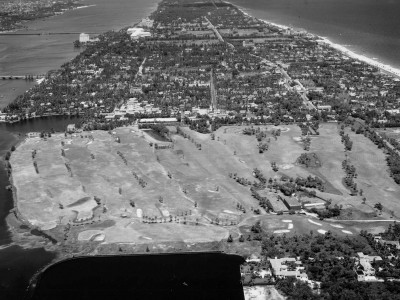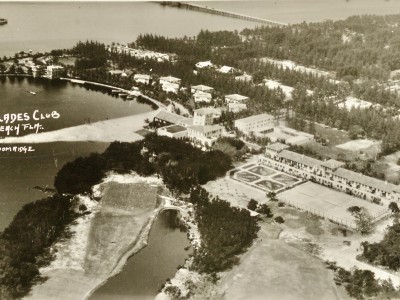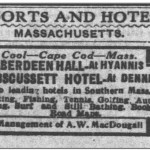Of all the enduring mysteries associated with Seth Raynor, who designed the second nine holes at the Everglades Club stands near the top.
For years it has been speculated that one of three architects was responsible for the expansion of the Palm Beach, Fla. club, which opened its 18 holes in January of 1929, three years after Raynor passed away. The candidates were Raynor, who would have designed the second nine before his death, Raynor’s protégé Charles Banks and William Langford. Langford, an architect/golfer, was active in the Palm Beach area during the time the Everglades was expanded and often played the course. Langford would go on to renovate the course in 1936.

The 18-hole Everglades Club golf course, most likely taken in the early 1930s, within a few years of opening.
These were nothing more than guesses, though. There is absolutely not an iota of evidence that any of the three had a hand in the layout. In addition, it is apparent after just a mere glance at aerials of the Everglades in the few years after the second nine opened that what was in the ground did not even approximate, never mind match, the styles of Raynor, Banks or Langford.
The answer to the nagging question of who was responsible for expansion is Alexander W. MacDougall, the manager of the Everglades at the time the holes were built. He came to the club in 1926 after stints as manager at Olympic Fields Club in Chicago as well as a hotel manager in Massachusetts, and West Virginia among other locations.
The first reference, thus far discovered, crediting MacDougall appeared in the Jan. 30, 1929 issue of the Palm Beach Daily News, a publication for the Palm Beach winter crowd that was printed from December to March annually. It was a sister publication of the weekly Palm Beach Life magazine, which ran the story in a February issue. Neither has been digitized. A hard copy of the articles crediting MacDougall was recently found by a fellow researcher and me in the Palm Beach County Historical Society.
The mystery-solving story appeared under the headline, Golfers Praise New Nine-Hole Course at Everglades Club.
“A.W. MacDougall, manager of the Everglades Club, at one time connected with the Olympia Fields golf establishment of Chicago and a golf architect of ability, following the general construction of the late Seth Raynor, who laid out the first nine of this club and designed the Winter club course at Kelsey City, supervised construction of the course. MacDougall was assisted by C.C. Kelly, expert greenskeeper, formerly with the Kelsey City nine-hole course.”
Photos of the 18-hole course when it was in its infancy make it apparent that MacDougall renovated Raynor’s work, as well. The bunker style and placement did not match anything Raynor created before or after the Everglades course.
Construction on the second nine began in the spring of 1928 but was halted by the devastating Okeechobee hurricane that made landfall near West Palm Beach, Fla on Sept. 17, 1928. It is considered the fourth deadliest hurricane in U.S. history, causing the death of approximately 2,500 people in the United States, alone. The 145-mph winds did significant damage to the new holes which were to open in the fall of 1928.
“The hurricane wiped out almost all of the work, but since that time grass has been sowed on the fairways and greens,” read one newspaper account.
Shortly after the storm, work resumed. The second nine was formally first played in mid-January of 1929, three years after Raynor’s death, most likely with less-than-ideal turf conditions. It was reported that a total of nearly 900,000 cubic yards of soil were pumped off the bottom of the Intracoastal Waterway to create land for the holes.
MacDougall designing the second nine was corroborated in the poem “Original Facts About the Everglades Club,” published in March 1951,” by Caiaphas Horace Applewhite, who had worked at the club since 1925.
He wrote, “Mr. Paris Singer was the president/And when came depression down he went/Mr. Rorick took over before the ’23 storm/And appointed Mr. McDougal (sic) manager, both loyal and strong/He added nine more holes to the golf course/And every man on the job had to take his dose”

The original 9th hole at the Everglades Club, a Biarritz, was lost when the course expanded to 18 holes. (Photo Courtesy the Library of Congress.)
As far as MacDougall’s credentials as reported in the news story, his qualifications to be referred to as a “golf architect of ability” seem to not exist. The accolades may have been concocted by Paris Singer, the one-man show behind the creation and operation of the Everglades Club, to legitimize MacDougall’s work. No record has been found of MacDougall designing any other courses. It is possible that while working stints as a hotel manager he laid out rudimentary holes for facilities. A 1910 newspaper advertisement had MacDougall simultaneously overseeing two properties on Cape Cod, Massachusetts, the Aberdeen Hall in Hyannis and Nobscussett Hotel in Dennis. According to Olympia Fields records, MacDougall was appointed club manager in October of 1921. His tenure appears to have lasted until 1924. In the April 1923 issue of the club magazine, MacDougall wrote about working on an 18-hole estate course, Great Island (Mass.) Golf Club, in 1905, his introduction to golf. That year, Walter Travis won the invitational matchplay event at the course located on property owned by Charles B. Corey. MacDougall remained on good terms with Olympia Fields after leaving. An advertisement in a 1926-27 club publication contained an ad for Royal Palm Way Apartments that was under the direction of the Everglades Club. Interested parties were directed to write to MacDougall at the Everglades. In 1924, while the course was under construction, MacDougall went to work for Rolling Greens Country Club in Arlington, Heights, 25 northwest of downtown Chicago.
MacDougall was a naturalized American citizen who was born in Nova Scotia in 1878. He remained with the Everglades until at least 1935. During that time he ascended to the role of an officer for the company, serving as secretary and then secretary-treasurer. While working for the Everglades, MacDougall became well-to-do and achieved status in the Palm Beach winter community. He played golf on the Everglades course and newspaper items had him intending to build homes on Australian Avenue and Brazilian Avenue, both very near the club. In 1935 he bought a waterfront lot on Singer Place for $4,045. Parties he and his wife hosted were important enough to make the social pages of the local newspapers. In the mid-1930s, he became a real estate broker based in Palm Beach.MacDougall may have later worked at a Miami hotel.
He died in 1964 at the age of 86 while residing with his wife in Nashville, Tenn. MacDougall’s obituary listed the Everglades Club as the only place he ever worked but did not mention that he was the architect of the second nine holes.
(Updated 2-28-2024 to show MacDougall’s tenure at Olympia Fields.)
(Updated 2-29-24 to show Walter Travis won a 1905 event at Great Island golf course.)
(Updated 4-1-24 to include excerpt from the poem, “Original Facts About the Everglades Club.)

